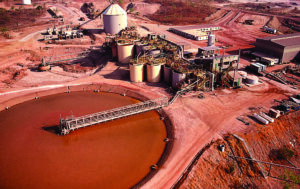Taking a more holistic, long-term view of tailings technologies will benefit companies, communities and other stakeholders.
Mining companies are analysing more alternatives to tailings storage facilities (TSF) earlier for new projects as they respond to the global industry standard on tailings management (GISTM) and stakeholder expectations.
Launched in August 2020, the GISTM sets a global benchmark for environmental, social and technical outcomes from tailings management. The goal is zero harm to communities and the environment from tailings facilities worldwide.
The GISTM has been widely adopted by members of the International Council on Mining and Metals (ICMM). These companies had until August 2023 to conform to the GISTM for tailings facilities, with “extreme’” or “very high” potential consequences for not doing so. All other tailings facilities have until 2025 to conform.
Requirement 3.2 of the GISTM necessitates operators of new tailings facilities to undertake a multi-criteria alternative analysis of all feasible sites, technologies and strategies for tailings management. They should consider TSF alternatives over the project life cycle and address environmental, technical and socioeconomic impacts.
The goal is twofold: select a TSF alternative that minimises risks to people and the environment through the TSF life cycle, and minimise the volume of tailings and water placed in external tailings facilities.

The GISTM requires the process to be reviewed independently and disclosed to stakeholders in order to aid public accountability.
SRK Consulting senior tailings engineer Sam Kendall said the GISTM’s requirement for the early evaluation of alternative tailings technologies and strategies has significant implications for new and established mining companies.
“In the context of GISTM compliance, there is increased attention being paid to the assessment of best available practices and/or best available technologies; however, some established mining houses have long been applying these principles,” Kendall said.
“Some miners are drawn to short-term capex (capital expenditure) and opex (operational expenditure) without sufficiently considering the longer-term, less tangible aspects of TSF design, which also derive value.
“For newer companies at the very early stages of project development, the initial selection of a low-cost, status quo tailings management solution can be appealing, particularly when considering time and budget constraints.
“During the initial stages of project development, it can be easy for project managers without specific tailings experience to favour selecting a familiar, cost-effective solution; however, with large-scale uptake of the GISTM, the industry is being encouraged to invest in optimising tailings management to find more sustainable, long term, cost effective solutions.”

Kendall believes expectations are changing with the implementation of the GISTM and all miners developing new TSFs are expected to demonstrate that they are working towards a defensible evaluation of management options.
“This is an important consideration for mining companies, particularly those looking for early-stage investment from institutions which expect GISTM compliance,” Kendall said.
“More broadly, this process also influences perceptions from regulators, communities and the public. Companies should understand this change and be taking steps now to adapt to it.”
Sustainable growth
According to Kendall, the long-term benefits of comparing TSF alternatives can far outweigh the extra cost and risk, particularly when there are unique project drivers or TSF constraints.
“Examining alternative TSF technologies will help mining companies to implement the optimal result on mine-waste design, now and in the future,” he said.
“Fundamentally, it’s about being future-focused and open-minded about TSF technologies.”
Documenting and disclosing the process used to consider TSF alternatives has other benefits, Kendall said, including project transparency and stakeholder collaboration. Similarly, adopting this approach helps to demonstrate environmental, social and governance (ESG) principles in TSF and cultivate a more holistic view of tailings management going forward.”
Arguably, the main benefit of this approach is the potential to “future-proof” TSF design.
“Given life of mine is often 10-plus years, it is well worth exploring options that have the potential to improve the risk profile of the operation and licence to operate into the future,” Kendall said.
“Business-as-usual-type facilities might not be able to maintain acceptability, as ongoing public disclosure requirements set a high bar for the mining industry in general.”
Kendall acknowledges, however, that this approach adds extra cost and risk for smaller mining companies. Assessing more TSF alternatives requires greater internal resources or use of industry consultants. Documenting the process to select a TSF technology and strategy, and having it independently reviewed, adds other costs.
The main risk for smaller miners when selecting alternative tailings management approaches, such as large-scale filtration (reducing the amount of water transported from a processing plant to a TSF) or co-disposal (combining tailings and waste rock), is reliability and the potential for operational delays.
“These are important considerations that can be addressed with time,” Kendall said.
“Mining companies that don’t adhere to GISTM requirements around TSFs will find it increasingly hard to attract capital from investors or will have to pay a higher cost for that capital.”
Stakeholders have demanded more rigorous and stringent TSF processes after the catastrophic tailings dam collapse at Vale’s Córrego do Feijão mine in Brumadinho, Brazil, in January 2019.
“Investors are scrutinising TSFs in more detail than ever,” Kendall said. “They recognise the immense reputational risk that can arise from a tailings failure, and the potential destruction of mine value.”
Kendall believes it is a good sign that mining companies are starting to adopt GISTM principles for tailing facilities.
“Like many things in mining, change usually starts at the top and works its way down,” he said. “There’s no one-size-fits-all approach.”
The key is a different mindset.
“It’s easy to view a TSF as only a cost and focus mostly on its impact on project economics. It’s harder to identify and value the long-term, less tangible benefits of a successful TSF strategy and the damage caused if something goes wrong,” Kendall said.
“The GISTM provides an opportunity for mining companies to show stakeholders the process they went through to choose their TSF. That’s good for the company, communities, investors, and the environment.”
SRK Consulting is a leading, independent international consultancy that advises clients mainly in the earth and water resource industries. Its mining services range from exploration to mine closure. SRK experts are leaders in fields such as due diligence, technical studies, mine waste and water management, permitting, and mine rehabilitation.
This feature appeared in the October 2023 issue of Australian Mining.



.jpg)
